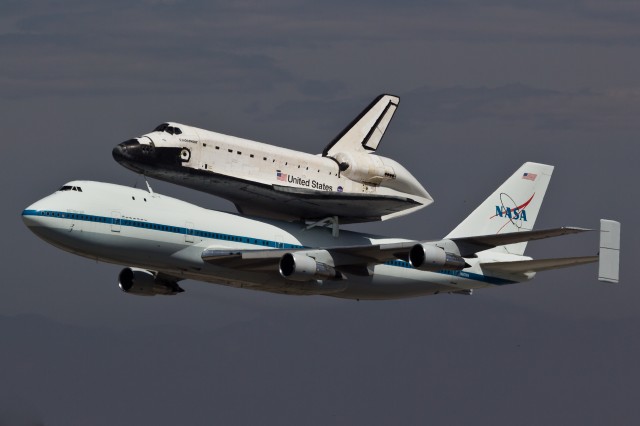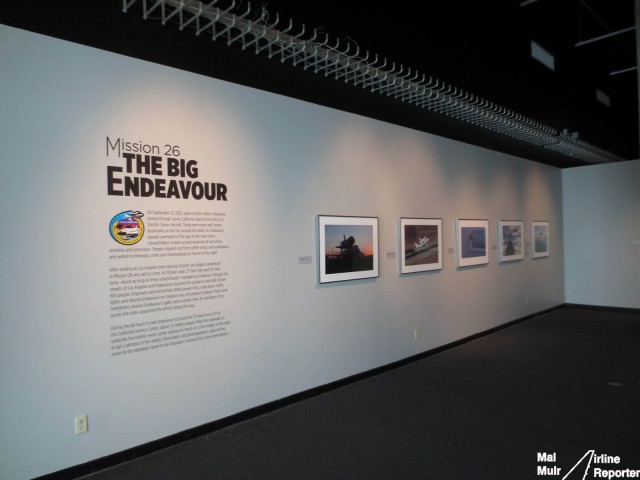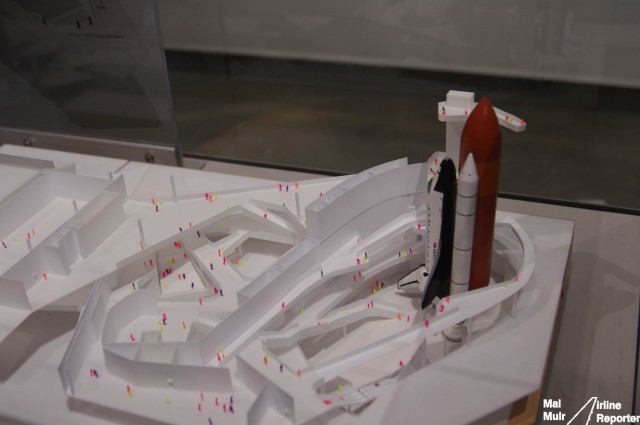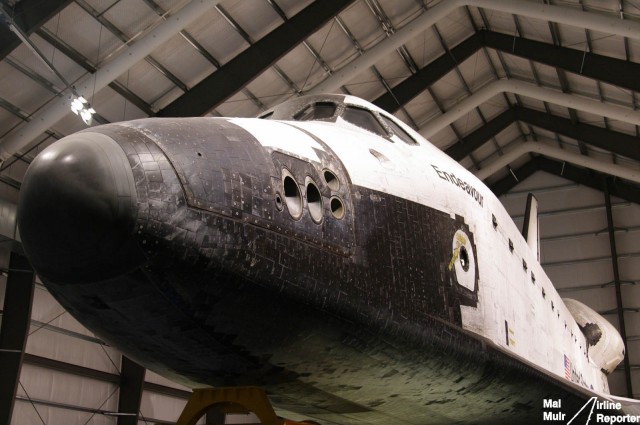
The Shuttle Endeavour rides to Los Angeles about a specially modified NASA 747 – Photo: Kevin Epstein – Aviation Photographic
When the final shuttle mission was flown by Atlantis, on July 8th 2011, the end of the NASA space shuttle program loomed. What would become of the magnificent aircraft (well spacecraft)?
Unfortunately the Museum of Flight in Seattle (where I am based) was unable to secure a shuttle, they did however get the Shuttle Trainer. The trainer was delivered with some spectacle, as the Super Guppy brought in the major pieces over 3 flights. With the Smithsonian’s Udvar Hazy Center getting a shuttle (Discovery), the Kennedy Space Center getting another (Atlantis), the final one, Endeavour, went to the California Science Center.
BONUS: Super Guppy Delivers Space Shuttle Trainer to the Museum of Flight in Seattle, WA
With the expected crowds wanted to see the shuttle, it was ferried across the country to LAX on what felt like the world’s largest flightseeing aircraft — a specially modified 747 — called the Shuttle Carrier Aircraft. From this point the final mission for the Endeavour was ahead of it, but also a world’s first. A 12 mile journey across Los Angeles streets to its new (and temporary) home at the California Science Center.
The science center is located at Exposition Park, which is home to the University of Southern California, a handful of other museums and also the LA Coliseum, where the 1984 olympics were held. This makes it an ideal location to handle the crowds, as there is plenty of space (and there sure was a lot of crowds the day I visited). The museum has the usual science center exhibits but the drawcard (at least for many folks) is the Endeavour, which currently lives in a temporary exhibit.
BONUS: Video of NASA’s Boeing 747-123 (N905NA) Last Take Off as a Shuttle Carrier
The spacecraft is in pristine condition though as it still shows the battle scars (pointed out by my guide Shell Amega) from its last mission into space. I would not have even realized these deep scars had they not been pointed out to me and it was these scars that had Cmdr Mark Kelly, who commanded STS-134, to make a go/no go decision. His choice was to either conduct a dangerous spacewalk to fix the damage or reenter the atmosphere with the damage as is. Cmdr Kelly made the decision to reenter as is, and they all made it back safely, finishing their final mission.
But the displays don’t just end at the shuttle itself. There are also a number of exhibits dedicated to the shuttle program including a genuine ’œSpace Potty’ where crew used the facilities in spaceflight (including the curtain installed just for when females first joined the shuttle program). There is the Rocketdyne Operations Support Center taken piece by piece exactly from the day of the last shuttle mission and put back together at the Science Center, including down to the position of mugs, pencils etc.

Misson 26 is a fantastic exhibition showing the people and places the shuttle went through on its journey across Los Angeles: Photo – Mal Muir | AirlineReporter.com
The one exhibit that really attracted me though was not the galley or the laboratory where the experiments were conducted in the cargo bay. It was ’œMission 26,’ which is a display of photographs used to chronicle the final mission for Endeavor and its journey through the streets of Los Angeles. This was a precision operation with laser measuring used to ensure that the shuttle did not damage things and any tree removed was later replanted (and they have been, with more to come).
Mission 26 though is full of the most stunning of photographs and video showing this journey through the streets. Not just of the shuttle itself but of the people, those who ventured out to welcome Endeavour to its new home.
BONUS: Video of Space Shuttle Discovery Launch Viewed From Airliner
Currently the California Science Center is building a true Air and Space wing to house the shuttle. NASA was a little bit puzzled and really worried that the plans were a bit out of left field as the shuttle will return to an upright position. Just as though it was sitting on the famous launch pad 39A at the Kennedy Space Center in Florida. It will sit surrounded not only by other spacecraft, satellites and displays but other aircraft as well. Once completed in 2017, it should make this a fantastic addition to aviation and space in Southern California.

The New Planned Air & Space Gallery at the California Science Center: Photo – Mal Muir | AirlineReporter.com
A visit to the California Science Center and the Shuttle Endeavour are free, but booking them online before you arrive (and thus a $2 fee) is the best avenue. Access to the shuttle is limited and the day I was there (in the middle of spring break mind you) tickets sold out early! It is still worth it though, the shuttle was a magnificent icon of just what we can achieve when we set our mind to it & it will hopefully continue to inspire people in our future.
 |
This story written by…Malcolm Muir, Lead Correspondent. Mal is an Australian Avgeek now living and working in Seattle. With a passion for aircraft photography, traveling and the fun that combining the two can bring. Insights into the aviation world with a bit of a perspective thanks to working in the travel industry. |

Is the exhibit indoors or outdoors? I’m pretty sure one of NASA’s requirements was for the orbiters to be in a controlled environment, but that’s gonna be one tall museum to house the vertical stack.
It is currently indoors and the new one will be indoors as well. Not sure how they are going to do the new facility but yeah, if its at ground level for the bottom of the stack… its going to be huge. I have a feeling they would probably recess the bottom of the facility into the ground some to reduce that height.
“I would of not even realized…” (sic) may be how one speaks, but “I would have not…” seems to me to be correct grammar, right?
Yup and fixed — thanks,
David
What….No pix of the old UA DC-8 for airlinereporter? LOL.
Sure be nice if the STS had a replacement flying!! I guess not until we have the next President. Depending on who wins that is. DOH
Always with the politics…
Sounds like an awesome exhibit. Your last line makes me wonder if we will ever again have something that brings the country together like the space program did, and if so, what could it possibly be?
Thats the thing… will we?? Its hard to tell what the future will bring.
The Olympics were held in 1980, not 1982 in L.A. when the Russians boycotted them.
Correction, 1984. I have fat fingers.
Thanks, this is fixed. I must of been getting confused with Commonwealth games years.